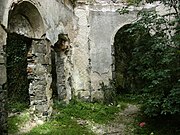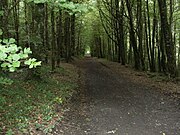House in County Mayo, Ireland
| Moore Hall | |
|---|---|
 Moore Hall façade, County Mayo in 2010 Moore Hall façade, County Mayo in 2010 | |
 | |
| General information | |
| Type | House |
| Architectural style | Georgian |
| Classification | Derelict |
| Town or city | Carra, County Mayo |
| Country | Ireland |
| Coordinates | 53°42′48″N 9°13′35″W / 53.7134°N 9.2263°W / 53.7134; -9.2263 |
| Estimated completion | 1795 |
| Technical details | |
| Material | limestone |
| Floor count | 3 over basement |
| Design and construction | |
| Architect(s) | John Roberts |
Moore Hall, the house and estate of George Henry Moore and family, is situated to the south of the village Carnacon in the barony of Carra, County Mayo, Ireland in a karst limestone landscape.
Named for the Irish landed gentry family who built the estate between 1792 and 1795, Moore Hall lies on Muckloon Hill overlooking Lough Carra. The house was designed by the Irish architect John Roberts. Several members of the Moore family played major parts in the social, cultural and political history of Ireland from the end of the eighteenth century to the early twentieth century. The house was burned down in 1923 by anti-Treaty IRA during the Irish Civil War as Maurice Moore was viewed as pro-Treaty.
Background
The Moores were a landed gentry Irish family who built Moore Hall between 1792 and 1795. The first Moore of Moore Hall was George Moore, a wine merchant, a name borne by many members of the family down the generations. The Moores were originally an English Protestant family but some became Catholic when John Moore married a Roman Catholic, Jane Lynch Athy of Galway, and when their son, George, married Katherine de Kilikelly (a.k.a. Kelly), an Irish-Spanish Catholic, in 1765.
Notable members of the Moore family, associated with Moore Hall, include:

- George Moore (1727–1799), who built Moore Hall, originally came from Straide near Castlebar. During the time of the Penal Laws, George went to Spain where he was admitted to the Royal Court. From the 1760s until about 1790, George Moore made his fortune in the wine and brandy trade, running his business from Alicante. When the Penal Laws were relaxed at the end of the 18th century, he returned to County Mayo with a fortune of £200,000 and in 1783, bought over 12,000 acres (49 km) of land at Muckloon, Ballycally and Killeen from Farragh Mc Donnell, and commissioned the building of the grand residence of Moore Hall.
- George's son, John Moore (1767–1799), was educated in France and became a lawyer. With the rebellion of 1798, he returned to Mayo. General Humbert appointed him President of the Connacht Republic in Castlebar. Thus, John Moore was the first President of an Irish republic, albeit for a very brief interval. He was captured and, although initially sentenced to death, his sentence was later commuted to deportation. He died in the Royal Oak tavern in Waterford on 6 December 1799.
- George Henry Moore (1810–1870), was educated in the Catholic faith in England and later at the University of Cambridge. His main interest was in horses. At the height of the Great Irish Famine in 1846, he entered a horse called Coranna for the Chester Gold Cup and netted £17,000 from bets laid on the horse. He used his winnings to import thousands of tons of grain and cattle to aid his tenants. It is still remembered on the Moore estate that nobody was evicted from their home for non-payment of rent during hard times, and that there were no deaths there during the Famine. George Henry is buried in the family vault at Kiltoom on the Moore Hall estate.
- George Augustus Moore (1852–1933), was a writer during the Irish Literary Revival period. A number of notable writers of the time, including Lady Gregory, Maria Edgeworth, and W. B. Yeats were regular visitors to Moore Hall. George Augustus Moore was an agnostic and anti-Catholic. His ashes are buried on Castle Island on Lough Carra in view of the big house on the hill.
- Maurice George Moore (1854–1939), Senator Colonel Maurice Moore was the statesman of the family. He served with the Connaught Rangers in the Boer War and became concerned with human rights in South Africa. He was also involved with the co-operative movement in Ireland, founded by Horace Plunkett.
History
The house at Moore Hall was designed by John Roberts, an architect from Waterford who also designed Tyrone House in County Galway in a similar style. It was built between 1792 and 1796, and was occupied by various members of the extended Moore family until the turn of the 20th century.
Moore Hall house was burned down on 1 February 1923 during the Irish Civil War. An account of the burning was given shortly afterwards by the owner in a letter to the press.
Later ownership

The house, lake, farm, and estate is now owned by the forestry company, Coillte, and it is a visitor attraction in the area. The house is not open to the public due to its poor condition – it has not been refurbished since it was burned. Non-native forestry grows on the estate lands along with areas of natural regeneration of clearfell areas recently cut by Coillte. Trees have begun growing over the farm walls and buildings behind the ruins of the grand house. Local people who lived and worked on the Moore Hall estate remembered it fondly. The estate passed to the Irish Land Commission upon the death of George Moore, and a campaign to restore the house has been waged.
In 2018 the Mayo County Council purchased the 80-acre site with the intent of turning it into a tourist destination. The project is being undertaken as a strategic partnership between the Mayo Council, Coillte, and the National Parks and Wildlife Service. As of 2020, the first phase of work was underway, and included restoration of the Walled Garden, and new visitor facilities including walkways, seating, play areas and signage. Storyboards telling the story of Moore Hall, the Moore Family and their role in the history of the Irish nation are also planned for the site.
Gallery
References
- ^ "The Lake (video)". 2001. Archived from the original on 16 September 2010 – via oreillydesign.com.
- ^ "Moore Hall, Co. Mayo". North Atlantic Skyline. monasette.com. 27 July 2010. Archived from the original on 28 September 2011. Retrieved 27 July 2010.
- "Moore Hall, MUCKLOON OR MOOREHALL, MAYO". Buildings of Ireland. Retrieved 4 October 2021.
- Reid, Jamie (26 February 2021). "Ghosts and the Big House: rediscovering a lost world in Ireland". Financial Times. London. Retrieved 4 October 2021.
- Hone, Joseph (1939). The Moores of Moore Hall. London: Jonathan Cape.
- ^ Frazier, Adrian (27 July 2010). "George Moore, 1852–1933 (extensive section of book quoted in New York Times)". Yale University Press – via nytimes.com.
- ^ Coyne, Kevin (27 July 2010). "The Moores of Moorehall". mayo-ireland.ie.
- "Moores of Moorehall". oreillydesign.com. 27 July 2010. Archived from the original on 14 September 2010. Retrieved 27 July 2010.
- "Moores of Moorehall, County Mayo, Ireland, History". mayo-ireland.ie. Retrieved 27 July 2010.
- "Moore Hall". coillte.ie. Coillte. Retrieved 4 October 2021.
- "House: Moore Hall". Landed Estates Database. NUIG. Archived from the original on 28 January 2021.
Slater refers to it as the seat of George A. Moore in 1894
- "The Burning of Moore Hall (newspaper extract)". 14 February 1923. Archived from the original on 3 February 2020 – via oreillydesign.com.
- "Moore Hall House Video". Archived from the original on 14 September 2010. Retrieved 12 July 2010 – via oreillydesign.com.
- "Moorehall bought by Mayo County Council". The Mayo News. 5 January 2018. Retrieved 29 May 2022.
- "Minister Noonan Hails Strategic Partnership at Moore Hall and Environs As New Approach To Preserving and Developing Our Natural, Built and Cultural Heritage Sites". Comhairle Contae Mhaigh Eo. Mayo County Council. 22 July 2021. Retrieved 29 May 2022.
- "Major Transformation Underway at Historic Mayo Landmark". Western People. 4 July 2020. Retrieved 29 May 2020.
External links
- Moore family record at the Landed Estates Database, NUI Galway.
- Estate record at the Landed Estates Database, NUI Galway.

